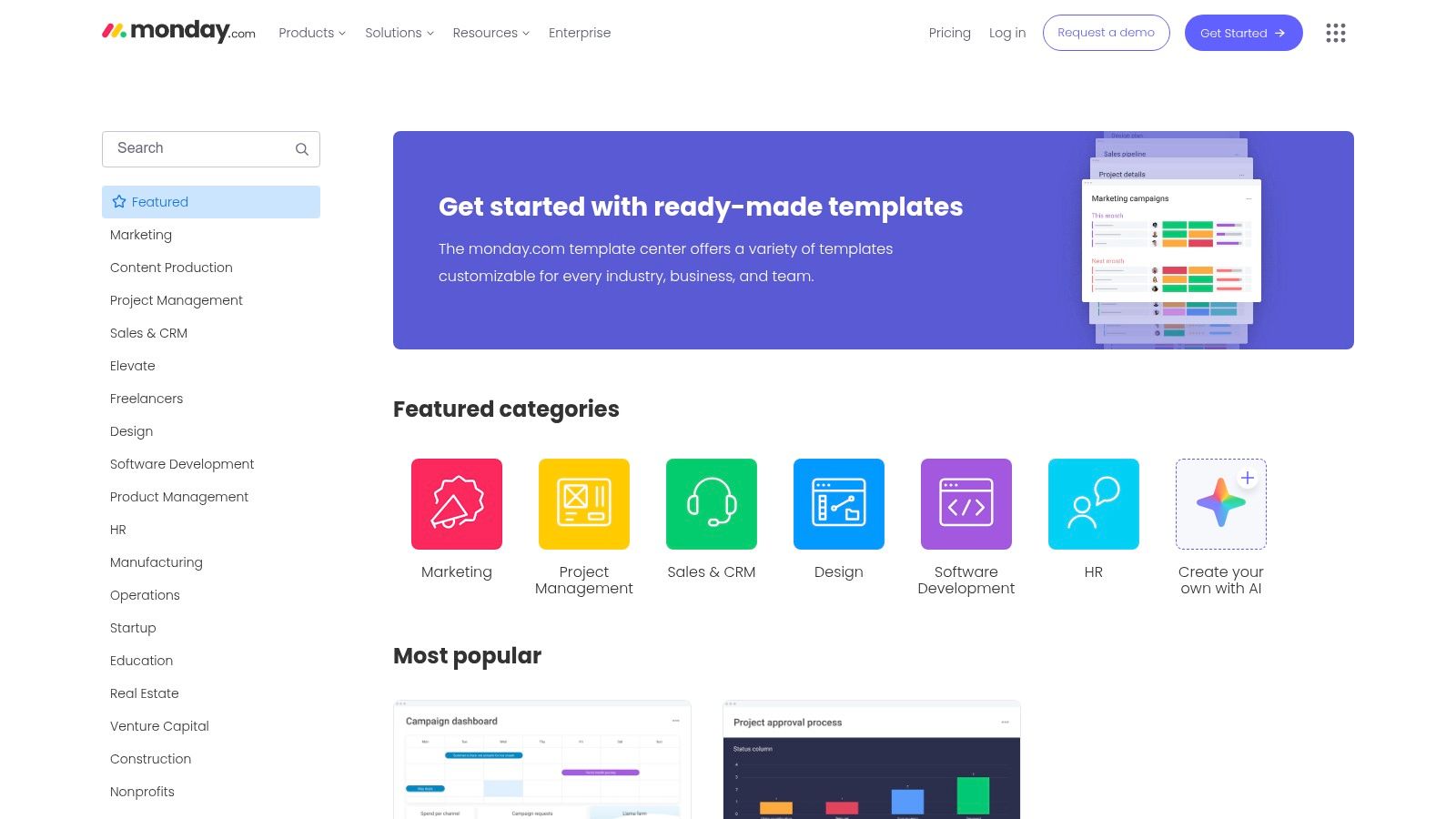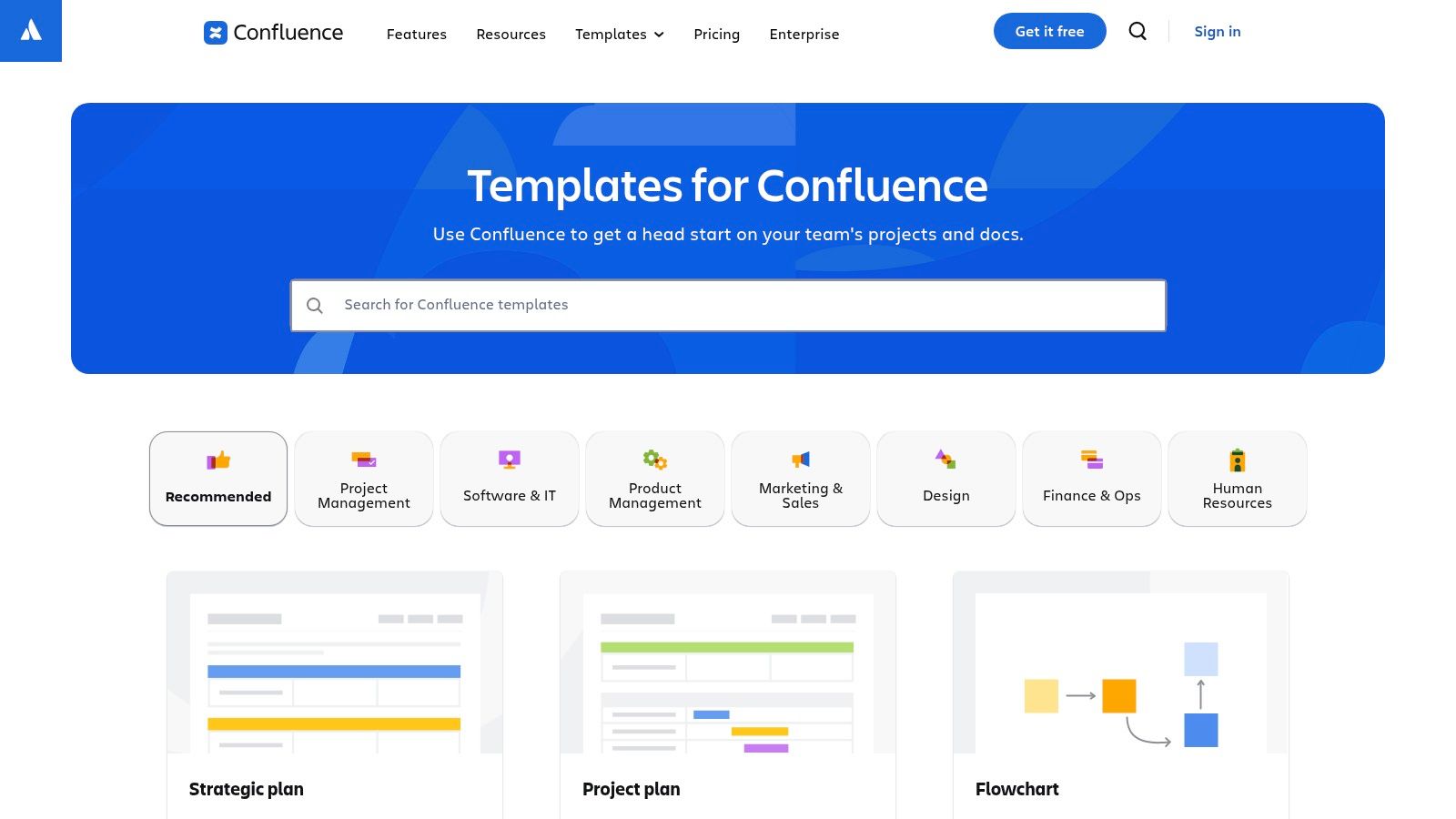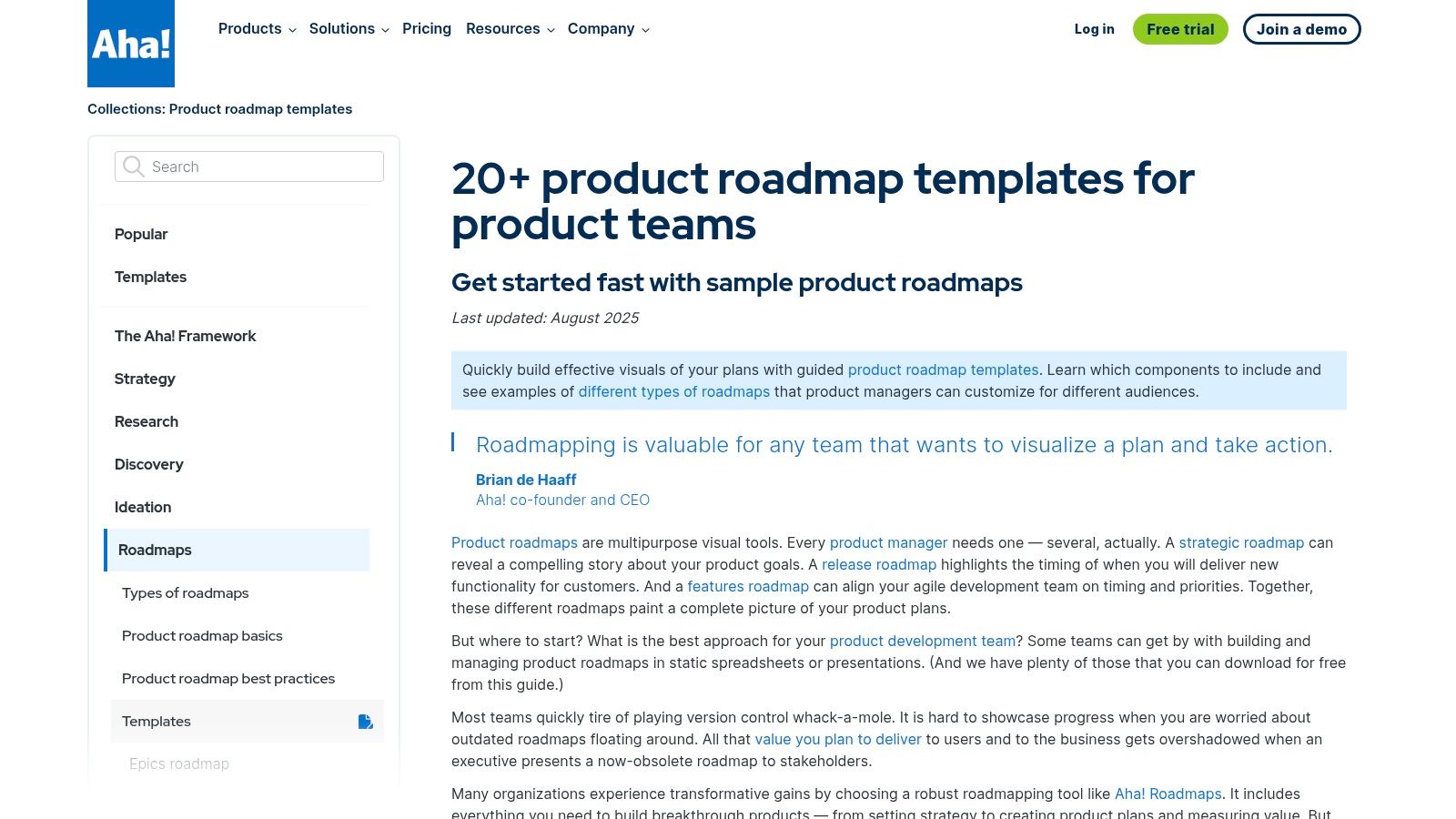12 Best Product Management Template Hubs for 2025
Find the perfect product management template for your team. Discover 12 curated resource hubs for PRDs, roadmaps, and backlogs to streamline your workflow.

In product management, consistency and clarity are king. A well-structured product management template doesn't just save time; it aligns teams, standardizes communication, and ensures critical details aren't lost in the chaos of development. From crafting the perfect Product Requirements Document (PRD) to visualizing your strategy on a roadmap, the right starting point prevents you from constantly reinventing the wheel. But with countless options scattered across the web, finding high-quality, actionable templates has become a time-consuming challenge in itself.
This guide cuts through the noise. We have curated the 12 best resource hubs where you can find battle-tested templates for every stage of the product lifecycle. Instead of just listing individual files, we focus on the most valuable platforms and marketplaces, like the Miroverse, Notion's Template Gallery, and Figma's Community, that offer a deep well of options.
Each entry provides a direct link, screenshots, and an analysis of its strengths and ideal use cases, helping you quickly find the perfect framework for your needs. Whether you need a simple backlog tracker for a startup or a comprehensive go-to-market plan for a major launch, this list will equip you with the tools to build better products, faster.
1. Notion Marketplace – Ultimate Flexibility for Integrated Docs
Notion has become a default operating system for many product teams, and its official Marketplace is a treasure trove of templates. It stands out by offering solutions that are more than just static documents; they are integrated, database-driven systems within a collaborative workspace. You can find everything from a simple Product Requirements Document (PRD) template to a comprehensive product management OS that links roadmaps, backlogs, user research, and meeting notes.
This platform excels at providing interconnectedness. A task in your sprint backlog can be directly linked to the user feedback that inspired it and the PRD that defines it. The quality varies, as the marketplace features templates from both Notion itself and third-party creators, with both free and paid options available. For product managers leveraging Notion, a dedicated Notion templates hub can provide an even wider array of specialized resources to get started. The true power lies in its adaptability; any product management template you find can be customized with new properties, views, and automations to perfectly fit your team’s unique workflow. This makes it ideal for teams that reject rigid, off-the-shelf tools.
2. Miro – Miroverse Template Library
For product managers who think and collaborate visually, the Miroverse is an essential, free resource. This community-driven library isn't for text-heavy documents like PRDs but excels at providing interactive canvases for the strategic rituals of product management. It's a goldmine for workshops, brainstorming sessions, and asynchronous collaboration, offering everything from a Product Manager’s Canvas to complex prioritization frameworks like RICE or MoSCoW.

Miroverse stands out by turning abstract strategies into tangible, collaborative spaces. A team can jump directly into a pre-built user story map or a customer journey template with a single click, instantly creating a shared workspace. The quality is consistently high, as many templates are contributed by industry experts and official Miro partners. While a Miro account is required and advanced collaboration features are tied to paid plans, the sheer volume and utility of the free product management template selection make it indispensable. It’s perfect for teams looking to facilitate more engaging discovery sessions and visually align stakeholders on strategy and priorities.
3. Figma / FigJam – Templates and Community
Where product and design workflows merge, Figma and its online whiteboard, FigJam, offer a unique, visually-driven template ecosystem. Their community hub is packed with resources that are inherently collaborative and interactive, bridging the gap between strategic planning and visual execution. You’ll find everything from detailed product roadmap templates and GTM plans to specialized boards for brainstorming, retrospectives, and prioritization workshops.

This platform excels at providing a shared canvas for cross-functional teams. Instead of a static document, a product management template in FigJam becomes a live artifact where engineers, designers, and PMs can add sticky notes, vote on features, and sketch out user flows in real time. The true power lies in its deep integration with the design process; a user journey map can live right next to the high-fidelity mockups it informs. While many templates are free, their effectiveness is highest when the entire team is already comfortable within the Figma ecosystem, as some templates prioritize design-centric thinking over pure process management.
4. ClickUp – Product Management Template Center
ClickUp positions itself as an all-in-one productivity platform, and its template center provides a powerful entry point for product teams seeking structure. Unlike platforms focused solely on documents, ClickUp's templates are pre-built, multi-view workspaces that instantly create interconnected systems for managing your entire product lifecycle. With a single click, you can deploy a comprehensive setup that includes roadmaps, sprint backlogs, bug trackers, and release plans, all linked within a unified environment.

The platform’s strength lies in its deep integration of tasks, docs, timelines, and goals. A product management template from ClickUp comes with preconfigured custom fields and statuses tailored for PM workflows, saving significant setup time. This makes it ideal for teams who want to move quickly from planning to execution without building a system from scratch. While the free plan offers a solid starting point, advanced features and some views are gated. The sheer number of features can also introduce a learning curve for teams new to the platform, but for those committed to its ecosystem, the ClickUp template library offers a remarkably fast way to stand up a complete and powerful product management space.
5. Asana – Product Templates
Asana offers a curated gallery of official templates designed to structure and streamline core product management workflows directly within its project management ecosystem. It stands out by emphasizing cross-functional visibility and clear ownership, making it a go-to for teams needing to coordinate complex projects across departments like engineering, marketing, and sales. You can find ready-to-use templates for everything from a product launch plan and roadmap to a bug-tracking system or a sprint planning board.

The platform excels at operationalizing product plans. Each task within a product management template has a clear assignee, due date, and status, eliminating ambiguity about who is doing what and when. With over 200 integrations with tools like Figma, Jira, and Slack, Asana acts as a central hub for execution. While the core templates are available on the free plan, accessing advanced features like custom fields, forms, and automation rules requires a paid subscription. This makes it ideal for product teams that prioritize structured execution and need a single source of truth for tracking progress from kickoff to launch.
6. monday.com – Template Center (Product Roadmap and more)
For teams that prioritize visual workflow management and stakeholder communication, monday.com’s Template Center provides a powerful, out-of-the-box solution. It goes beyond simple documents by offering interactive, plug-and-play boards designed for specific product management tasks like roadmapping, sprint planning, and backlog grooming. These templates come pre-configured with relevant columns, automation rules, and dashboard widgets, allowing teams to get started immediately with minimal setup.

The platform’s strength lies in its automation capabilities and stakeholder-friendly visualizations. A product management template on monday.com can automatically notify stakeholders when a feature's status changes or assign tasks based on specific triggers. Its colorful interface and multiple views, like Gantt and timeline, make it exceptionally easy to present complex plans to non-technical audiences. While many templates are free, access to more advanced features and automations is often gated by higher-tier plans, and the per-seat pricing model can become costly for larger teams. The Template Center itself is well-organized, clearly explaining what’s included in each template and which plan is required to use it effectively.
7. Atlassian Confluence – Product Management Template Collections
For teams deeply embedded in the Atlassian ecosystem, Confluence’s official template library is the gold standard for documentation-driven product management. It provides a curated collection of templates specifically designed to create durable records for decisions, specifications, and plans. You can find everything from a classic Product Requirements Document (PRD) and a strategic roadmap to OKR planning and competitive analysis frameworks, all built to live alongside your development work in Jira.

This platform's primary strength is its seamless integration with Jira. A line in a PRD can be highlighted to instantly create a Jira issue, linking engineering tasks directly to the documented requirements and rationale. This creates a powerful, traceable workflow from ideation to execution. While the templates are more structured and document-centric than those found in more flexible tools like Notion, they excel at creating a single source of truth for large, complex projects. For product managers who value robust, interconnected documentation, the Confluence templates provide a formal and effective way to manage and communicate product strategy within a development-focused environment. This makes it an essential resource for any team already leveraging the Atlassian suite.
8. Coda – Gallery of Docs and Packs for Product Teams
Coda elevates the concept of a document into a powerful, interactive application for product teams. Its gallery is filled with templates that are much more than static pages; they are modular, all-in-one docs combining text, tables, buttons, and automations. You can find comprehensive product team hubs, decision-making logs, prioritization frameworks, and dynamic meeting forums. Coda’s unique strength lies in its "Packs," which integrate tools like Jira, Figma, and Slack directly into your documents, pulling live data and enabling cross-platform workflows.

This platform excels at building a custom, centralized product operating system. For instance, a roadmap template can be connected to a feedback table and a launch checklist within the same doc, with views tailored for executives, engineers, and marketers. While many templates in the Coda Gallery are free to copy, its extreme flexibility means teams must invest time to tailor solutions to their specific needs. This adaptability makes it perfect for teams who want to build a truly bespoke product management template that mirrors their unique processes. Its approach to blending data and narrative is particularly useful when implementing frameworks, as detailed in this Jobs to be Done template guide.
9. Aha! – Roadmap and Whiteboard Templates
For product managers who need to create polished, presentation-ready roadmaps, Aha! offers a suite of professionally designed templates. Unlike general-purpose tools, Aha! is a dedicated product management platform, and its templates are purpose-built for strategic communication. The collection focuses heavily on different roadmap variations, providing specific layouts for strategy, portfolio, features, releases, and epics, ensuring you have the right visual for the right audience, from engineers to the C-suite.

A key advantage is the ability to communicate a clear product story. Each product management template is designed with configurable timelines, swimlanes, and progress indicators that are ideal for executive and customer-facing presentations. While Aha! provides free downloadable Excel and PowerPoint roadmap templates, the true power is unlocked within its integrated software environment where whiteboard concepts can be converted directly into actionable work items. This makes it an excellent choice for teams that want to bridge the gap between high-level strategy and detailed execution, though its most powerful features require a paid subscription.
10. ProductPlan – Product Roadmap Templates and Kits
ProductPlan offers a dedicated library of templates specifically designed for creating visually compelling and stakeholder-ready product roadmaps. It moves beyond static documents by providing templates that can be used within their software to build live, shareable roadmaps tailored for different audiences, such as executives, development teams, or customers. The platform excels at translating strategic initiatives into clear, high-level visual timelines. You can start with a template for an OKR roadmap, a release plan, or a theme-based overview and customize it with your specific goals and initiatives.

The primary strength of ProductPlan's offering is its focus on communication. Features like visual swimlanes, color-coded strategic goals, and flexible time horizons make it simple to convey complex plans quickly. While the templates themselves are free to browse, their true power is unlocked within the ProductPlan platform, which is available via a 14-day free trial. The main limitation is that continued use and collaboration require a paid subscription, making it a better fit for teams ready to adopt a dedicated roadmapping tool. This approach is perfect for product managers who need a powerful product management template for creating presentation-quality roadmaps. For a deeper dive into structuring technical plans, you can explore this guide to creating a technical roadmap.
11. Airtable – Product Management Templates and How‑Tos
Airtable functions as a powerful, spreadsheet-database hybrid, making it exceptionally suited for dynamic product management tasks. Its template gallery offers pre-built "bases" for everything from user research and bug tracking to launch calendars and feature roadmaps. The platform's core strength is its ability to visualize the same underlying data in multiple ways. A product roadmap can be a standard grid, a Kanban board for sprint planning, a Gantt chart for timeline visualization, or a calendar for key launch dates, all drawing from a single source of truth.

This multi-view capability makes Airtable a superior choice for teams that need to present information to different stakeholders in different formats without duplicating work. For instance, a product management template for feature prioritization can use a grid with custom formulas for RICE scoring, then switch to a Kanban view grouped by status for development updates. While some of the how-to guides and examples can feel dated, the core templates are highly adaptable. The platform is ideal for PMs who want to build a centralized, database-driven system for their artifacts, but unlocking its most powerful features, like advanced automations and integrations, will require a paid plan.
12. Etsy – Digital Product Management Templates Marketplace
While not a dedicated B2B software platform, Etsy has become a surprisingly robust marketplace for digital product management templates. It stands out by offering a vast, decentralized collection of assets from individual creators, providing an alternative to more standardized corporate solutions. You can find everything from a polished product roadmap template in Google Sheets to a comprehensive product launch kit in PowerPoint, often with unique designs and layouts you won't find elsewhere. The marketplace is perfect for finding a specific, low-cost asset without committing to a larger system or subscription.
The strength of Etsy lies in its sheer variety and affordability. Because you are buying from individual sellers, you can often find a highly specific product management template, like a development tracker or a user interview dashboard, for just a few dollars. The user review and rating system is crucial for vetting the quality and usability of a template before purchasing. However, this model means quality can be inconsistent, and post-purchase support or template updates depend entirely on the individual seller. It’s an ideal choice for product managers needing a quick, affordable, and visually appealing one-off tool for a specific task.
Top 12 Product Management Template Comparison
| Item | Core Features ✨ | UX & Quality ★ | Value & Pricing 💰 | Target Audience 👥 | USP / Best Use 🏆 |
|---|---|---|---|---|---|
| Notion Marketplace – Template Gallery | Thousands of doc+database PM templates; 1‑click duplicate | ★★★★ — quality varies | 💰 Free + paid templates; Notion account needed | 👥 Notion users, doc-first PMs | 🏆 Largest selection of DB‑native PM blueprints |
| Miro – Miroverse Template Library | Workshop canvases, discovery & prioritization templates | ★★★★ — visual, easy to use | 💰 Mostly free; advanced collaboration on paid plans | 👥 Workshop facilitators, cross‑functional teams | 🏆 Best for visual workshops & async collaboration |
| Figma / FigJam – Templates and Community | Design‑first roadmaps, workshop boards, widgets | ★★★★ — interactive & remixable | 💰 Free/community; paid for team features | 👥 Design+product teams, workshop leaders | 🏆 Tightest design ↔ product collaboration |
| ClickUp – Product Management Template Center | Integrated tasks, docs, boards, Gantt in templates | ★★★ — powerful but steeper learning curve | 💰 Free templates; advanced views on paid tiers | 👥 Teams needing unified task+doc workspace | 🏆 Fast to spin up full PM workspace with views |
| Asana – Product Templates | Backlogs, launches, owner/status tracking, integrations | ★★★★ — simple & cross‑functional | 💰 Free templates; advanced features on paid plans | 👥 Cross‑functional teams, stakeholders | 🏆 Clear ownership + broad integrations |
| monday.com – Template Center | Visual boards, automations, preset columns/views | ★★★ — visual and automation‑friendly | 💰 Template uses often require paid plans (per‑seat) | 👥 Ops/exec stakeholders, execution teams | 🏆 Visual roadmaps + built‑in automations |
| Atlassian Confluence – PM Templates | PRDs, OKRs, launch plans; Jira integrations | ★★★★ — doc‑centric & scalable | 💰 Included in Atlassian stack (paid for enterprises) | 👥 Docs‑first orgs using Jira/Atlassian | 🏆 Best for durable specs & decision records |
| Coda – Gallery of Docs and Packs | Modular docs, tables, Packs, automations | ★★★★ — highly customizable | 💰 Many free templates; Packs/features may be paid | 👥 Power‑users building PM OS | 🏆 Flexible interactive PM operating system |
| Aha! – Roadmap and Whiteboard Templates | Polished roadmaps, portfolio and exec templates | ★★★★ — presentation‑grade visuals | 💰 Trial then paid subscription | 👥 Strategy teams, exec communications | 🏆 Professional roadmap storytelling for execs |
| ProductPlan – Roadmap Templates & Kits | Exec/customer roadmaps, live shareable plans | ★★★★ — stakeholder‑ready visuals | 💰 14‑day free trial; paid product afterwards | 👥 Roadmap owners, stakeholder-facing teams | 🏆 Fast to create live, shareable roadmaps |
| Airtable – PM Templates & How‑Tos | Multi‑view bases (Grid, Kanban, Gantt); record templates | ★★★★ — strong data modeling | 💰 Free + paid tiers for advanced features | 👥 Data‑driven PM teams, ops | 🏆 Multi‑view DB approach for PM workflows |
| Etsy – Digital PM Templates Marketplace | One‑off downloadable templates in many formats | ★★★ — quality varies by seller | 💰 Low‑cost one‑offs; pay per download | 👥 Budget teams, one‑time needs | 🏆 Cheap, format‑flexible templates for quick wins |
From Template to Impact: Supercharge Your Prioritization
This extensive exploration of product management templates from platforms like Notion, Miro, and Aha! demonstrates that the right framework is crucial. We've navigated a diverse landscape, from the highly visual and collaborative environments of FigJam and Miroverse to the structured, task-oriented ecosystems of ClickUp and Asana. Each tool offers a unique starting point for organizing the chaos inherent in product development.
However, the true value of any product management template is not in its structure alone, but in its ability to drive decisive action. A beautifully designed product roadmap or a meticulously organized backlog is only a static document until it's infused with strategic priorities. The ultimate goal is to move beyond mere organization and transform these templates into dynamic blueprints for growth and innovation.
Choosing Your Foundation: A Quick Guide
Selecting the ideal template platform depends heavily on your team's existing workflow and specific needs. To make the right choice, consider these factors:
- For Deep Integration: If your team already lives in an ecosystem like Atlassian or Asana, starting with their native templates is the most frictionless path. This minimizes context switching and leverages existing integrations.
- For Maximum Flexibility: Platforms like Notion, Coda, and Airtable offer unparalleled customization. Choose these if you need to build a bespoke system that molds perfectly to your unique processes, even if it requires more initial setup.
- For Visual Collaboration: When ideation, brainstorming, and stakeholder alignment are top priorities, the infinite canvases of Miro and FigJam are unmatched. They excel in the early, creative phases of product development.
Activating Your Template with Data-Driven Insights
Once you've chosen your template, the real work begins: populating it with meaningful priorities. A common pitfall is relying on gut feelings or the "loudest voice in the room." A list of 100 feature requests doesn't inherently reveal which one will reduce churn by 5% or unlock a new market segment. This is where the process transitions from documentation to strategy.
To truly make an impact, product management templates should directly supercharge your prioritization efforts. For deeper insights into this process, explore resources on effective feature prioritization strategies. By connecting qualitative user feedback with hard business metrics like revenue and churn risk, you can move beyond simple feature tracking. This approach ensures your chosen product management template becomes a powerful engine for strategic growth, not just a glorified to-do list. Ultimately, the best template is the one that helps you confidently answer the most critical question: "What should we build next to achieve our goals?"
Ready to populate your new templates with priorities backed by revenue data? SigOS analyzes customer feedback from all your sources and connects it directly to business impact. Stop guessing and start building what truly matters. Try SigOS today.
Keep Reading
More insights from our blog


